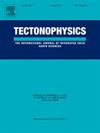1999年西北地震带İzmit (MW = 7.5)和d zce (MW = 7.2)地震时应力变化:对地震活动性变化和地震危险性的影响
IF 2.7
3区 地球科学
Q2 GEOCHEMISTRY & GEOPHYSICS
引用次数: 0
摘要
本文计算了1999年北安纳托利亚断裂带(NAFZ) İzmit (MW = 7.5)和d本文章由计算机程序翻译,如有差异,请以英文原文为准。

Time-dependent stress changes associated with the 1999 İzmit (MW = 7.5) and Düzce (MW = 7.2) earthquakes in NW Türkiye: Implications for seismicity changes and earthquake hazard
In this study, we calculated coseismic and time-dependent viscoelastic (VE) postseismic Coulomb stress changes of the 1999 İzmit (MW = 7.5) and Düzce (MW = 7.2) earthquakes along the North Anatolian Fault Zone (NAFZ). We assessed these changes in relation to the seismicity surrounding MW ≥ 5.0 earthquakes and the selected faults and locations. Excluding the 2009–2011–2012 Simav and 2020 Kırkağaç earthquake sequences, the calculated stress changes coincided with the observed seismicity changes. Our findings suggest that stress changes from nearby MW > 6.0 earthquakes provided approximately 1.9 bars of stress load for the 2009 Simav earthquake, yet only a minor stress increase (about 0.07 bars) for the 2020 Kırkağaç earthquake compared to the stress decreases (about −0.3 and − 0.18 bars, respectively) caused by the 1999 mainshocks. Nevertheless, geological and seismological evidence from published studies indicates that magma-driven stress changes may have influenced occurrence of the Kırkağaç earthquake. For the 2006 Gemlik earthquake, the coseismic stress shadow was neutralized by VE postseismic stress load at its hypocenter in 2006, suggesting it may be a long-standing off-fault aftershock of the 1999 İzmit earthquake. We also identified a seismicity shutdown due to stress shadowing along the Bursa and İnegöl faults, whereas significant stress loads caused high seismic activity along the Elmalık and Bakacak faults, as well as at the Akyazı and Gölyaka locations. Additionally, stress change calculations along the Middle Strand of the NAFZ reveal that VE postseismic stresses have been generally rising since 1999, effectively reducing negative or augmenting positive coseismically imposed stress changes. Given the last ruptures of the Middle Strand in 1419 and 1556, this fault strand may be capable of producing two earthquakes in the order of MW = 7.2–7.3.
求助全文
通过发布文献求助,成功后即可免费获取论文全文。
去求助
来源期刊

Tectonophysics
地学-地球化学与地球物理
CiteScore
4.90
自引率
6.90%
发文量
300
审稿时长
6 months
期刊介绍:
The prime focus of Tectonophysics will be high-impact original research and reviews in the fields of kinematics, structure, composition, and dynamics of the solid arth at all scales. Tectonophysics particularly encourages submission of papers based on the integration of a multitude of geophysical, geological, geochemical, geodynamic, and geotectonic methods
 求助内容:
求助内容: 应助结果提醒方式:
应助结果提醒方式:


